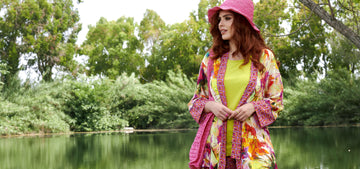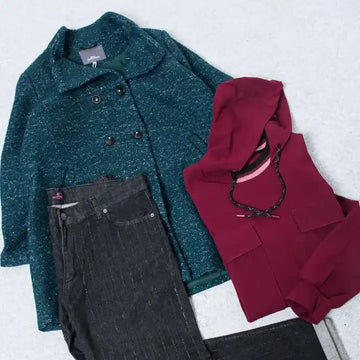
Let's clarify the fashion fabrics that make up the garments we wear every day or that we are interested in buying.
In these articles you will find descriptions that tell a bit of history and characteristics about the following fabrics:
- Cotton and recycled cotton
- Denim
- Elastane
- Wool
- Linen
- Nylon
- Polyacrylic
- Polyester
- Polyamide
- Rayon
- Viscose
Cotton and recycled cotton
Cotton fabric is obtained by weaving cotton yarns obtained from the hair that covers the seeds of a plant of the Gossypium species. The term cotton fabric generally means not only loom-made fabrics, but also knitwear and jersey.
Cotton was obtained in the past by working with wooden tools or by hand. After taking the cotton boll from the plant of the same name, a ball of filaments was obtained which was treated and worked before being sent to the textile industries. Cotton, whose term derives from the Arabic katun or land of conquest already present before the second millennium BC in India and also in Peru, was first introduced in Sicily in the 9th century and then throughout Europe.
Characteristics:
- Feeling of freshness on the skin
- High liquid absorption capacity
- Soft to the touch
- washing up to 60° (cotton can be washed by hand or in the washing machine without particular problems as it improves its resistance when wet; it is necessary to avoid drying in direct sunlight because it weakens and turns the fiber yellow.)
The fibers of recycled cotton they derive from pre-consumer waste generated during the processing of virgin raw materials and semi-finished products along the transformation chain, and from post-consumer waste , such as clothing, home textiles and fabric fibers in general having reached the end of their cycle of life.
The largest volume of recycled cotton is produced through pre-consumer waste, although the largest amount of textile waste is post-consumer. This is because it is easier to recycle pre-consumer than post-consumer.
Thanks to the increasingly widespread concept of eco-design, designers tend towards a "zerowaste" production where clothes and accessories are designed to minimize, or even eliminate pre-consumer waste. Obviously we are still talking about many tons of textile waste produced in the world, but a minimal figure when compared to post-consumer waste.
Post-consumer waste is more difficult to recycle and sort due to the different colors involved and the blends of fibers that make up the fabric, as well as the toxic substances present.
Denim or also called jeans fabric was originally composed of 100% cotton but over the years more "blends" were born such as the addition of Lycra or Elastane to make the fabric elastic.
When he was born he was blue, the blue that still distinguishes him today.
It is called denim (in English) because it takes its name from the city "de Nimes" where it was produced. in France, instead they called it blue de Genes (Genoa blue) because it was exported through the port of Genoa which had a strong textile tradition.
Characteristics:
It has a diagonal weave and is therefore a particularly robust fabric suitable for workwear, unlike the "canvas" which is woven with perpendicularly crossed threads and does not have robust characteristics.
Denim fades progressively with washing and use, lightening more where the friction is greater.
- Neutral to odors
- Regulate humidity
- Optimal thermal insulation
- Softness
- 100% ecological
- OV protection
In 1940, nylon was described as a fiber "strong as steel, thin as a spider's web, yet more elastic than all common natural fibers." Obviously, it was a commercial operation aimed at sponsoring this new fabric.
There are two types of nylon on the market, distinguished according to the polymer used during production: nylon 6,6, which is obtained from hexamethylenediamine adipate and nylon 6 , the fruit of cuprolactam. To these is also added nylon 11 , obtained from castor oil. The number that accompanies the name refers to the number of carbon atoms present within the molecule.
Characteristics:
- Quick drying
- Soft, elastic and durable
- Moisture resistant
- Affordable price
Polyacrylic
Polyacrylic fibers are made from acrynolitril, which is first cured and then spun into a fiber, in both a wet and dry process. These fibers resemble wool to the touch and are resistant to chemical agents and light. They are particularly suitable as a filler for materials that must be soft and warm. They are very popular fibers due to their strength and ease of handling.
Polyester
Polyester is one of the most used synthetic fibers in the textile sector, exactly it is a polymer deriving from waste and recycled materials or from bacterial fermentation.
It was introduced into the British trade as a textile material in 1948 under the brand name Terylene.
Among the different types, the one used for fabrics is the so-called PET, or polyethylene terephthalate which, depending on the type of processing, can give light to other textile materials that we know very well, such as organza and fleece.
Characteristics:
- Elastic
- Resistant
- Stain resistant
- Moisture resistant
- Water repellent
These are the main characteristics of polyester, resulting in a very resistant and interesting fabric. Precisely because of its qualities, it is often used together with other natural fibers such as cotton and wool to give resistance to garments.
Polyamide
Polyamide is one of the most used materials in the contemporary textile industry. Its constitution is not particularly difficult to obtain, although the different chemical types modify its characteristics and qualities.
Nylon is a set of synthetic fibers obtained by spinning polymers and by the reaction of an acid (adipic acid for example) on a chemical product derived from petroleum. The macromolecules that are formed starting from the two prime monomers are presented in the form of pellets.
Subsequently melted and handled properly, they are treated through a supply chain and solidified, so as to obtain filaments of different types.
Rayon
Also known as "artificial silk", Rayon is a semi-artificial textile fiber that is obtained from a natural element, cellulose, through chemical processing.
The chemical products used in the production of traditional rayon are particularly polluting, in the world of ethical fashion rayon is replaced by lyocell.
Rayon fiber is defined as semi-synthetic as it derives from a natural raw material , however transformed with the use of chemical processes.
The cellulose is converted into a liquid compound through the use of chemical components, at this point the liquid is passed through small holes and subsequently converted back into the form of fiber.
Features :
- Extreme softness
- Feeling of freshness
- Shine
- can be dyed in all shades
Viscose
Viscose is a highly breathable fabric which gives a touch of freshness to our body and for this reason it is very pleasant to wear it in direct contact with the skin. It was born with the name of vegetable silk, as it was created by man specifically to emulate the characteristics of softness of natural silk, but with a decidedly lower cost.
Viscose is a fabric of natural origin that is very resistant to wear and tear , biodegradable, it absorbs colors very well which appear brighter than classic natural fabrics . Viscose is often mixed with other fabrics such as cotton and polyester, to give the garments additional special characteristics. It is also mixed with elastane and spandex to ensure the right amount of stretch.
The most widespread viscose is certainly Rayon, and it is also the "oldest" version of viscose. For (often) commercial purposes, today viscose takes on different names depending on the manufacturer, but despite changing the production process and the raw material used, it always remains an artificial fiber.
Ecological vegetable viscoses:
- Bamboo viscose
- Eucalyptus viscose (lyocell)
- Beech viscose (modal)
- Milk viscose (lanital)
- Orange viscose (orange fiber)
- Corn viscose
- Castor viscose
Being an artificial fiber of natural origin, viscose fabric has greater moisture absorption properties than other textile fibers. By preventing the formation of bacteria and the growth of dust mites, viscose fabric is often classifiable as hypoallergenic and thanks to this property it is also used to make blankets and sheets, as well as classic clothing and underwear.
Characteristics:
- Breathable
- Anti-microbial
- Elastic
- Light
- Soft
- Quick drying
- Does not shrink/bleed








